From our overnight stop in Morsbrunn, we were taken back to Surbourg by private car. In the church there was a morning attunement and explanations about the Romanesque church of St. Arbogast.


From the church, the path first leads downhill out of the village into the plain.
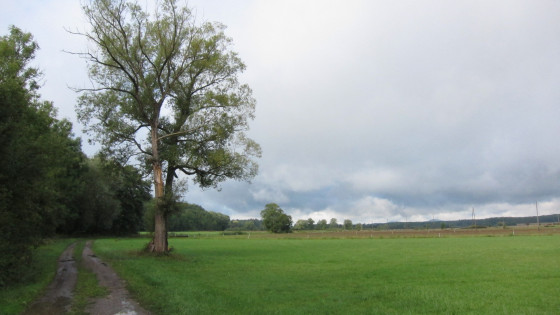
We walk along the D264 road, but then turn into Rue de la Scierie, which soon becomes a dirt road.

We then march along an abandoned railway line through a romantic forest.

At the end of the forest we come to Biblisheim.

There we visit St. John's Church

This is what it looks like in the Biblisheim church.
The lady on the wall is St. Thérèse of Lisieux.


We pass a wayside cross on the way to Walbourg.

Walbourg comes into view.

The group has stretched out a little on the way to Walbourg.
We walk directly to the church.
Église Sainte-Walburge

Der The village developed around the Benedictine Abbey of St. Walburga. The parents of Emperor Frederick Barbarossa were buried in the first monastery church: Duke Frederick II of Swabia († April 1147) and his wife Judith of Bavaria († 1130/31). The former abbey church now serves as the parish church of Walbourg.
Foundation of the monastery: 2 Benedictine monks from Bavaria, probably from Eichstätt, built a cell on the site of a hermitage at the end of the 11th
century, which was initially dedicated to St. Philip and St. James and St. Walburga. Walburga (ca. 710-779) was an Anglo-Saxon king's daughter, niece of Boniface. She was abbess of
the Benedictine monastery of Heidenheim. Construction of a Romanesque basilica as an abbey church began in 1105. The actual founder of the monastery is considered to be the Staufer
Duke Frederick I of Swabia (around 1050-1105).
The monastery flourished in the 12th and 13th centuries. In the 14th century it began to decline. In the 15th century the abbey church was rebuilt in Gothic style. The choir and
nave were enlarged at the same time.
Architecture, artistic decoration: Remains of the Romanesque basilica can still be seen on the south side outside.

The 3 middle windows in the choir from 1461 are from the famous workshop of Peter Hemmel from Andlau. Interesting is a depiction of the Emmaus scene in the right of the three windows: Christ appears here as a pilgrim.
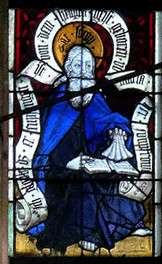
James is in the far left window of the choir with the banner (I believe that he is conceived by the Holy Spirit, born of Mary, the Virgin).
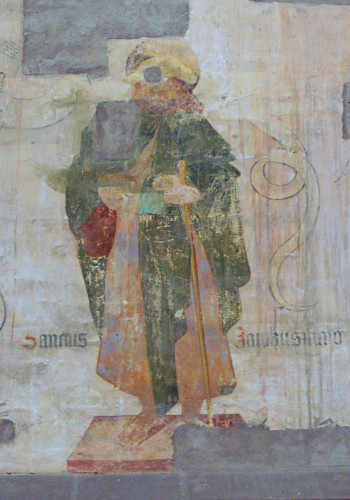
St. James is also depicted in the fresco on the choir wall (badly damaged).
The 3 (of 5) stained glass windows of the choir visible in the picture below:Right:Cycle "Glorious Christ" + "John the Baptist", Middle: Passion cycle, Left: Mary cycle + Saints cycle.

A baptism is being celebrated in the church and we don't want to disturb. In the background you can see the gothic windows.

In the middle window above you can see "Christ on the Cross" from the Passion Cycle. Click on it to see the scene larger!

It is hard to say goodbye to Walbourg because we could not visit the church, but we have to go on. Just outside the village of Walbourg we see Charolais cattle.

It goes on a cycle path through the forest, long and always straight ahead.

Picnic in the forest
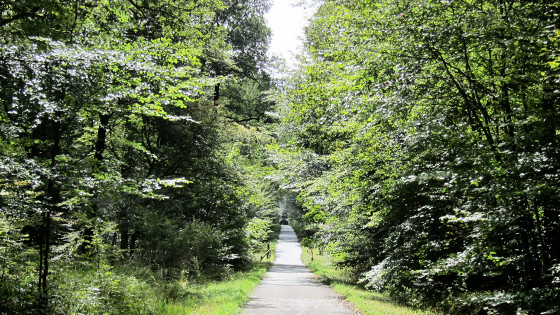
This picture doesn't look much different from the one before the lunch break, but this is the reality.

After a walk through the forest and along the road, we reach Haguenau.
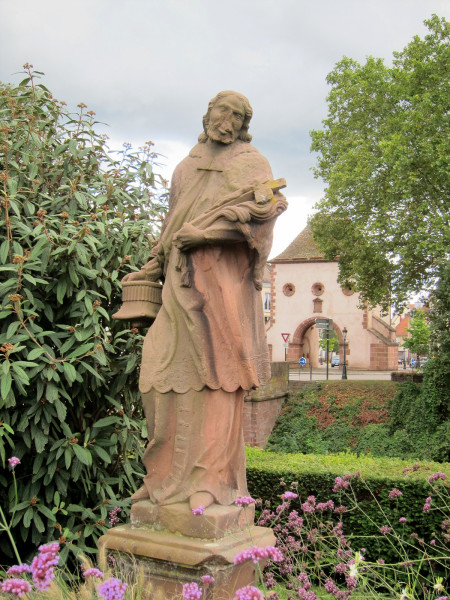
There is a statue of Nepomuk in front of the bridge over the Moder River that leads to the Wissembourg Gate.
Cross the bridge to enter the old town of Haguenau.


